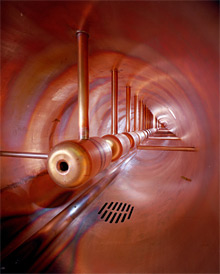Energy Frontier
Collider Physics
To explore the smallest particles, those inside an atom, physicists use the largest of scientific instruments, particle accelerators with a length measured in miles. These giant tools of particle physics can accelerate particles to very close to the speed of light.
All particle accelerators start from the principle that electrically charged objects exert a force on each other--opposite charges attract; like charges repel. If there are no other forces keeping the objects in place, the electric force will accelerate them. With an accelerator, physicists apply an electric force again and again to continually accelerate particles such as electrons, positrons, protons or antiprotons. In a circular accelerator, like Fermilab's Tevatron, the particles repeatedly pass the same force-exerting equipment and soon reach speeds close to the speed of light.
What is an accelerator?
A simple accelerator
To make the simplest kind of accelerator, physicists use a battery and two parallel metal plates separated by a gap. We connect one plate to the positive battery terminal and the other to the negative terminal. The battery creates an electric field in the gap between the two plates. Positively charged particles that enter the gap near the positive plate experience a force and accelerate across the gap toward the negative plate, gaining an amount of energy that depends on the voltage of the battery. For a 10-volt battery, a proton gains 10 electron volts, or 10 eV, as it accelerates between the plates. Putting many power supplies in a row, physicists have accelerated particles to millions of electron volts (MeV).
More powerful accelerators
At some point it is impractical to increase the voltage between the metal plates, as sparks will begin to fly across the gap. To accelerate particles to even higher energy, physicists use a large number of metal plates, all with a hole in the middle. Using alternating currents, the plates can be charged either positively or negatively. A positively charged particle, such as a proton, is drawn to the negatively charged plate in front of it, flying toward the hole. When the proton passes through the hole, the voltage of the plate is switched to a positive value, giving the proton an extra push. At the same time the next plate in front of the proton becomes negatively charged, attracting and accelerating the proton. Hence every gap between two plates provides energy to the proton as long as the voltage of the plates is switched whenever the proton crosses a hole. In high-energy accelerators, switching the voltage happens several billion times per second, or gigahertz frequencies.
Putting many plates in a row, physicists create linear accelerators, or linacs, that can accelerate charged particles to billions of electron volts (GeV). The more plates and gaps a linac has, the higher the energy it can give to a particle – and the longer the linac gets.
Ring-shaped accelerators
Rather than building longer and longer linacs, physicists are able to use magnets to guide charged particles in a circle. In doing so, physicists are able to send the particles again and again through the same set of plates, increasing the energy of the particles with each revolution.
As the particles gain energy, it is more and more difficult to keep them on the same circular path. The strength of the magnetic field must be increased. Ring-shaped particle accelerators operate the most powerful magnets in the world. The power of a ring-shaped proton accelerator is limited by its circumference and the strength of the magnets that are used. In the Tevatron, protons were accelerated to an energy of almost 100 billion electron volts, or 1000 GeV. This is also called 1 TeV, which inspired the name Tevatron.






